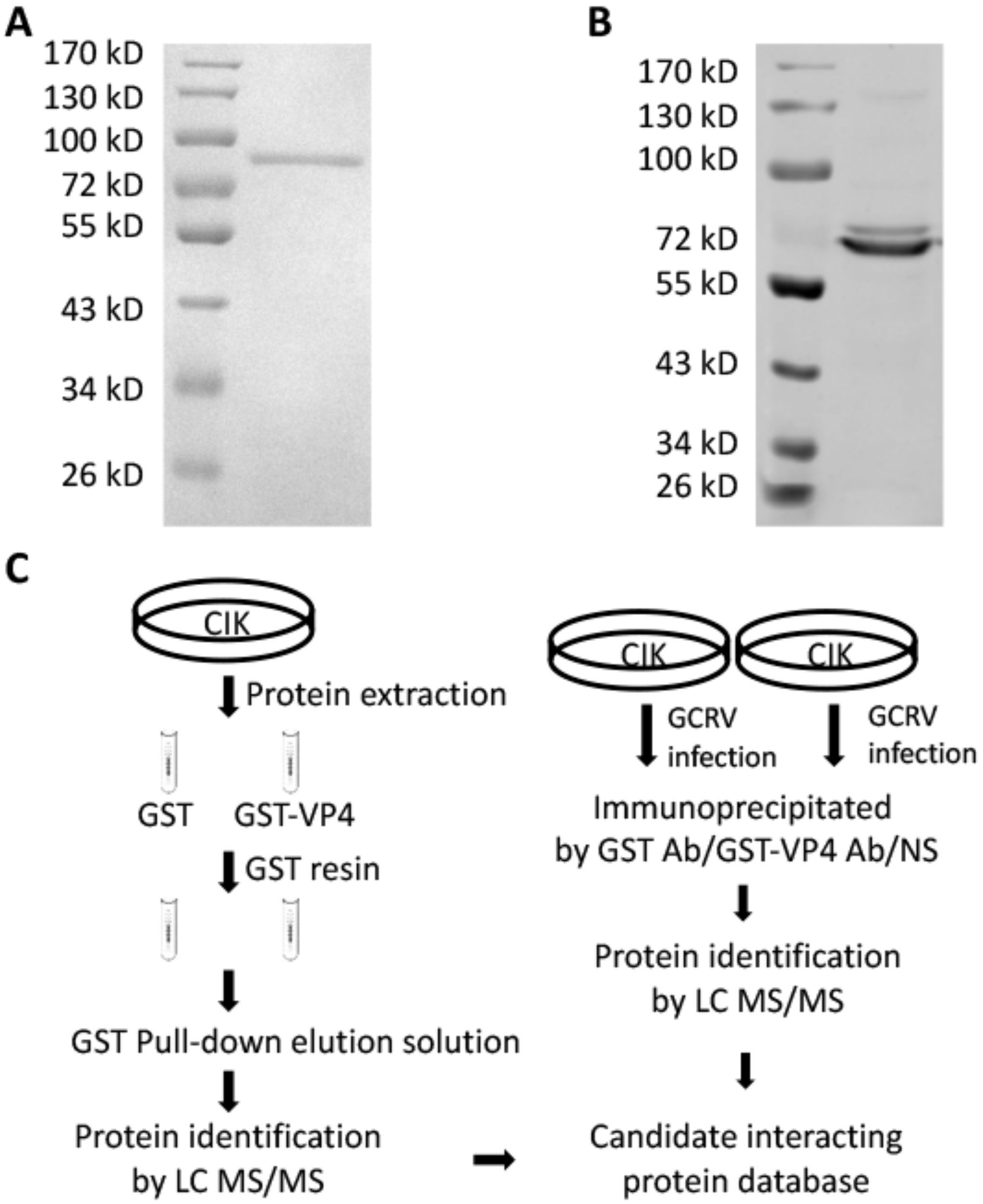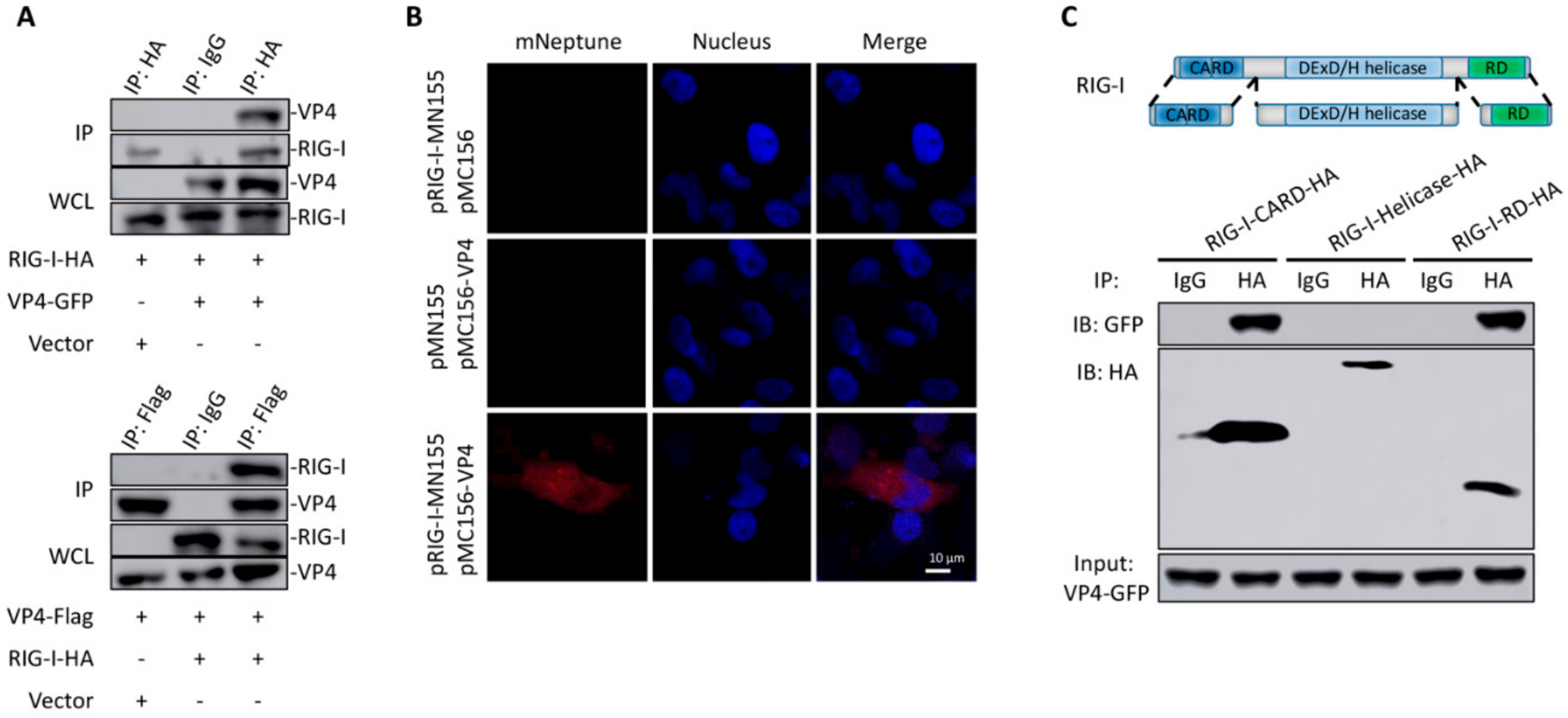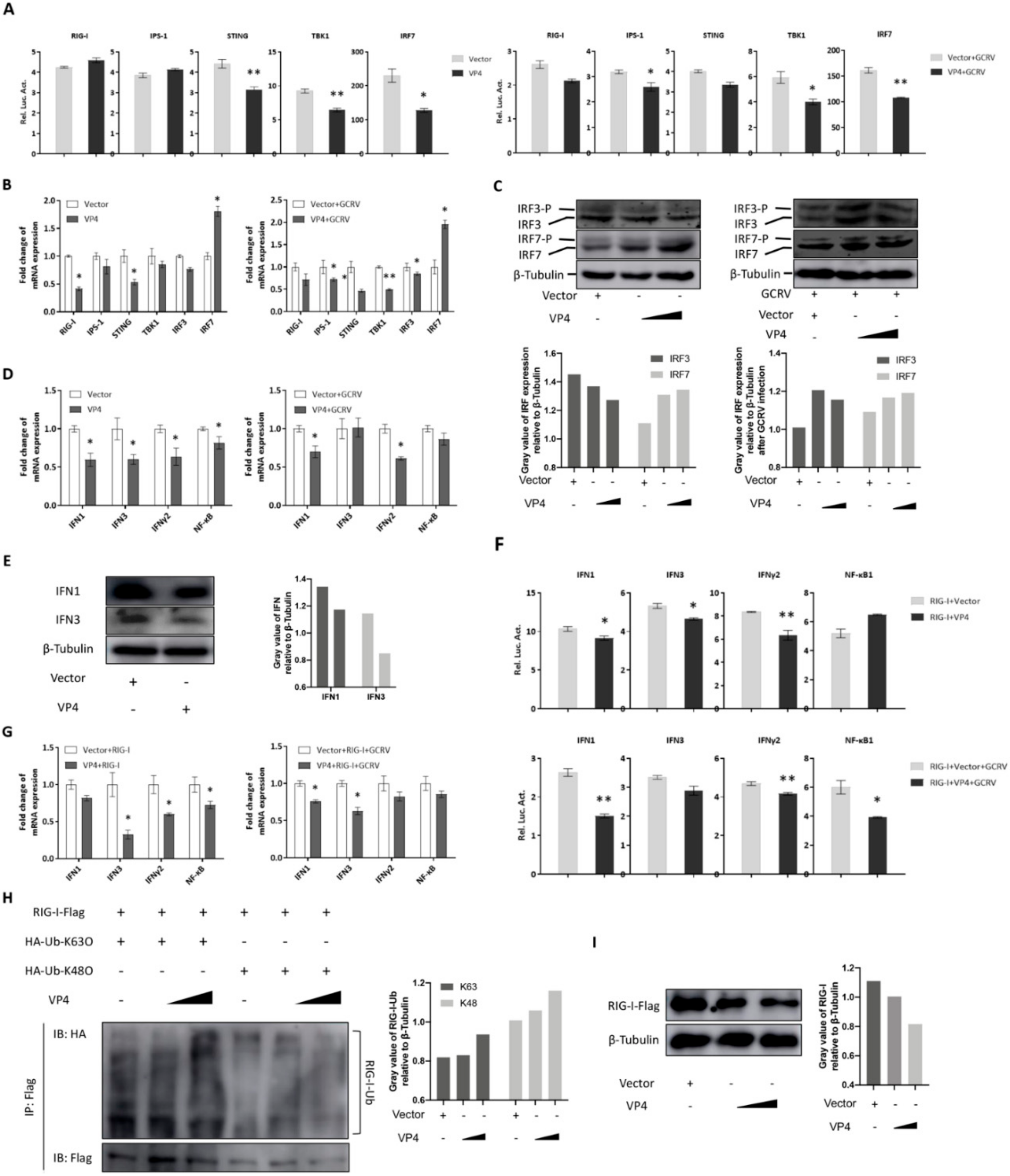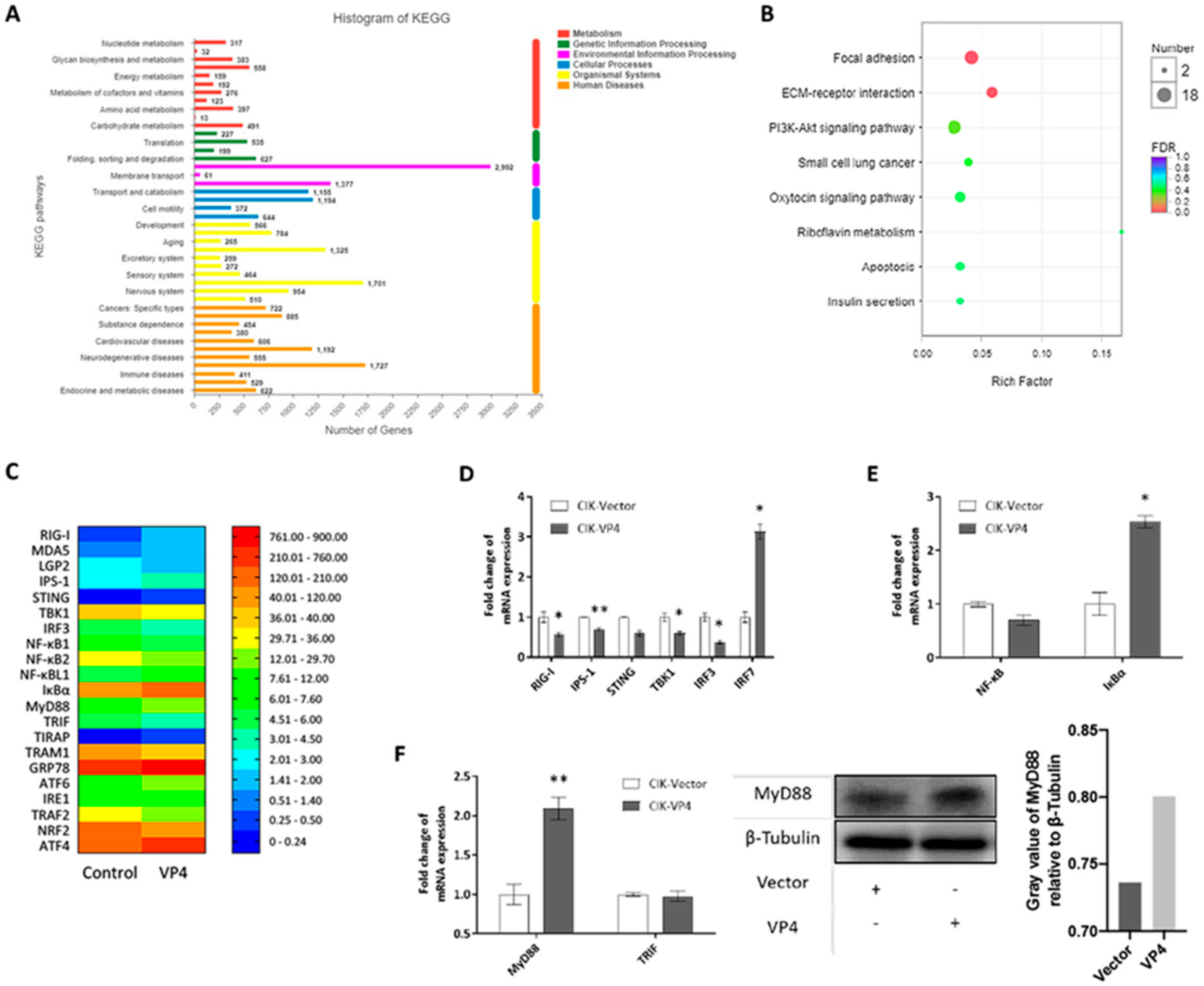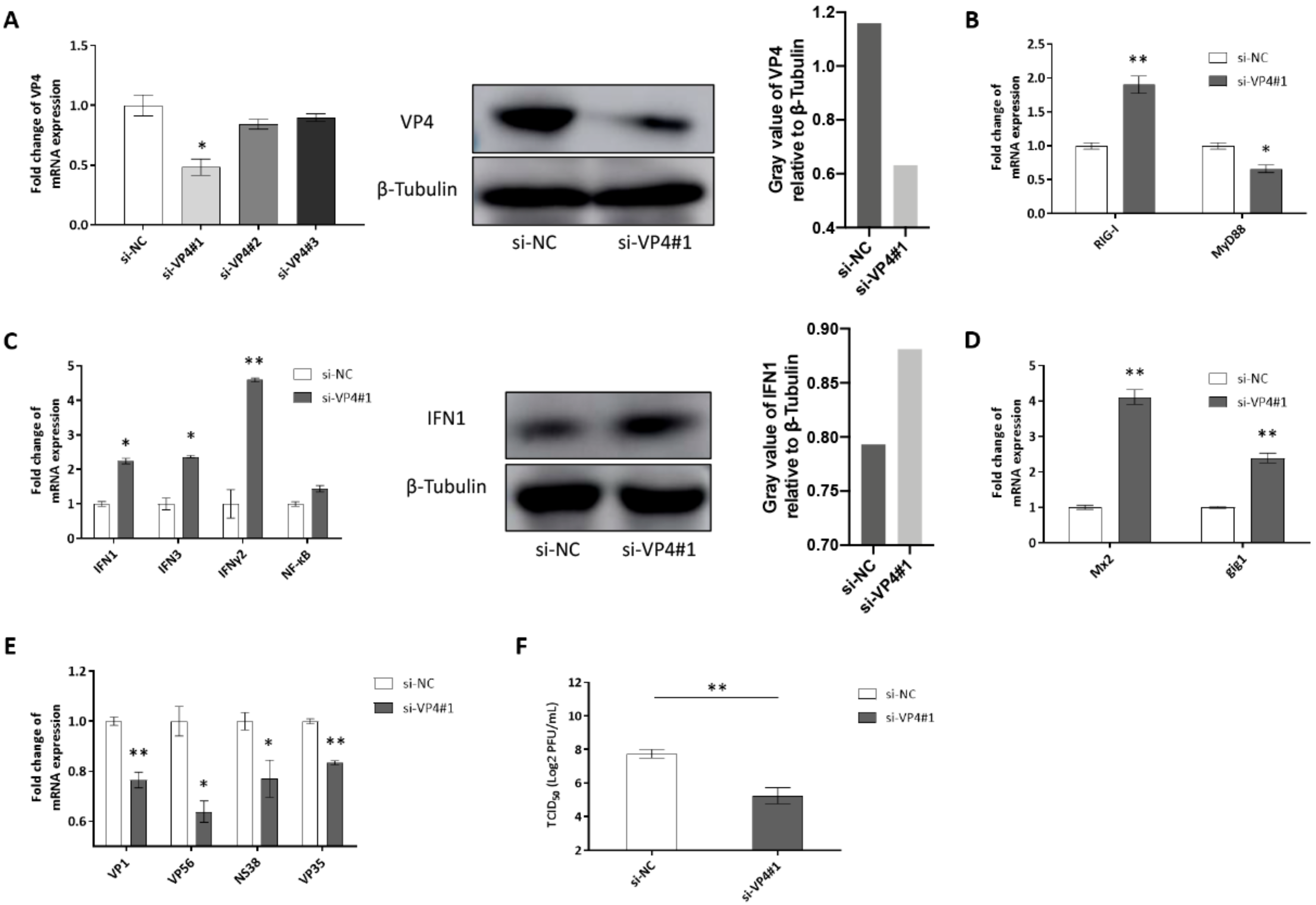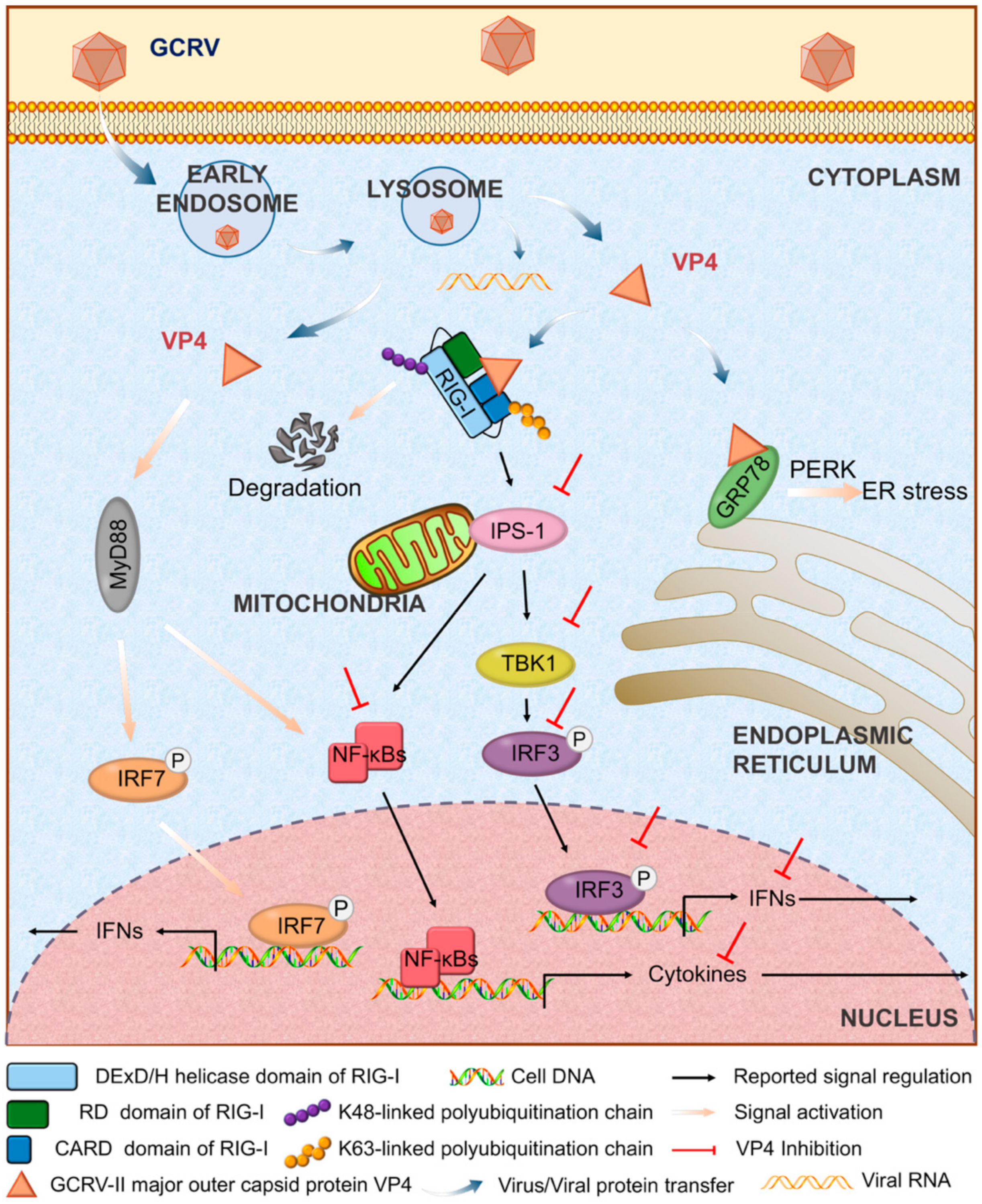Abbreviations
VP4, viral protein 4; CIK, Ctenopharyngodon idella kidney cell line; FHM, fathead minnow cell line; EF1α, elongation factor 1α; eGFP, enhanced GFP; RFP, red fluorescent protein; GCRV, grass carp reovirus; IB, immunoblot; WB, western blotting; IP, immunoprecipitation; BiFC, bimolecular fluorescence complementation; RIG-I, retinoic acid-inducible gene I; CARD, caspase activation and recruitment domain; DExD/H, DExD box helicase/ATPase domain; RD, repressor domain; IPS-1, IFN-β promoter stimulator-1; STING, stimulator of interferon genes; TBK1, TANK-binding kinase 1; GRP78, glucose-regulated protein 78; IRF, IFN regulatory factor; LAMP, lysosomal associated membrane protein; RAB, ras related in brain; ER, endoplasmic reticulum; TRIF, TIR-domain-containing adapter-inducing interferon-β.
Figure 1.
VP4 localizes to early endosome, lysosome, and endoplasmic reticulum (ER), but not late endosome. FHM cells were respectively transiently co-transfected with VP4-eGFP and LAMP2, a lysosome protein marker, VP4-eGFP and RAB5-RFP, an early endosome protein marker, VP4-eGFP and RAB7-RFP, a late endosome protein marker or VP4-eGFP and GRP78, an ER protein marker, and seeded on observation dishes for confocal microscope examination. After 48 h, the cells were fixed with 4% (v/v) paraformaldehyde and stained with DAPI. All samples were subsequently visualized using a confocal microscope. Green signals represent overexpressed VP4 and red signals stand for overexpressed LAMP2, RAB5, RAB7, or GRP78. The blue staining indicates nucleus. The yellow signals in the merged images indicate the co-localization between VP4 and organelle (original magnification × 40). All the experiments were repeated independently at least three times.
Figure 1.
VP4 localizes to early endosome, lysosome, and endoplasmic reticulum (ER), but not late endosome. FHM cells were respectively transiently co-transfected with VP4-eGFP and LAMP2, a lysosome protein marker, VP4-eGFP and RAB5-RFP, an early endosome protein marker, VP4-eGFP and RAB7-RFP, a late endosome protein marker or VP4-eGFP and GRP78, an ER protein marker, and seeded on observation dishes for confocal microscope examination. After 48 h, the cells were fixed with 4% (v/v) paraformaldehyde and stained with DAPI. All samples were subsequently visualized using a confocal microscope. Green signals represent overexpressed VP4 and red signals stand for overexpressed LAMP2, RAB5, RAB7, or GRP78. The blue staining indicates nucleus. The yellow signals in the merged images indicate the co-localization between VP4 and organelle (original magnification × 40). All the experiments were repeated independently at least three times.
Figure 2.
GST pull-down and co-immunoprecipitation (co-IP). (A) Purified prokaryotic GST-VP4 recombinant protein was analyzed by SDS-PAGE. Lane 1: Marker; Lane 2: GST-VP4. (B) GST-VP4 polyclonal antiserum prepared by our lab was detected by WB using CIK (C. idella kidney) cell sample infected with grass carp reovirus (GCRV). Lane 1: Marker; Lane 2: CIK protein detected by GST-VP4 antiserum. (C) Strategy of GST pull-down and co-IP. Left: Strategy for analyzing the interacting proteins of VP4 via GST pull-down and LC-MS/MS. CIK whole proteins were exacted from CIK cell line and incubated with prokaryotic GST or GST-VP4 protein. Pull-down was carried out with GST resin and the elution was analyzed by LC-MS/MS analysis on a Q Exactive mass spectrometer. Right: Strategy for analyzing the interacting proteins of VP4 via co-IP and LC-MS/MS. CIK cells were infected with GCRV for 24 h and co-IP with GST monoclonal Ab, GST-VP4 polyclonal antiserum or negative serum (NS). LC-MS/MS analysis was performed on a Q Exactive mass spectrometer. One experiment representative of three independent experiments was performed with three biological replicates.
Figure 2.
GST pull-down and co-immunoprecipitation (co-IP). (A) Purified prokaryotic GST-VP4 recombinant protein was analyzed by SDS-PAGE. Lane 1: Marker; Lane 2: GST-VP4. (B) GST-VP4 polyclonal antiserum prepared by our lab was detected by WB using CIK (C. idella kidney) cell sample infected with grass carp reovirus (GCRV). Lane 1: Marker; Lane 2: CIK protein detected by GST-VP4 antiserum. (C) Strategy of GST pull-down and co-IP. Left: Strategy for analyzing the interacting proteins of VP4 via GST pull-down and LC-MS/MS. CIK whole proteins were exacted from CIK cell line and incubated with prokaryotic GST or GST-VP4 protein. Pull-down was carried out with GST resin and the elution was analyzed by LC-MS/MS analysis on a Q Exactive mass spectrometer. Right: Strategy for analyzing the interacting proteins of VP4 via co-IP and LC-MS/MS. CIK cells were infected with GCRV for 24 h and co-IP with GST monoclonal Ab, GST-VP4 polyclonal antiserum or negative serum (NS). LC-MS/MS analysis was performed on a Q Exactive mass spectrometer. One experiment representative of three independent experiments was performed with three biological replicates.
![Biomolecules 10 00560 g002 Biomolecules 10 00560 g002]()
Figure 3.
Identification of RIG-I as an interacting protein of VP4. (A,B) Verification of the interaction between VP4 and RIG-I via co-IP assay and bimolecular fluorescence complementation assay (BiFC). (A) Upper: FHM cells were co-transfected with VP4-eGFP/vector and RIG-I-HA for 48 h. Co-IP was performed with anti-HA monoclonal Ab and mouse IgG (control), and immunoblotted (IB) with the respective Abs. Below: FHM cells were co-transfected with RIG-I-HA/vector and VP4-Flag for 48 h. Co-IP was performed with anti-Flag monoclonal Ab and mouse IgG (control), and immunoblotted (IB) with the respective Abs. (B) Imaging of the VP4-RIG-I interaction by using far-red mNeptune-based BiFC in vivo. pRIG-I-MN155 and pMC156-VP4 were transfected alone or co-transfected into CIK cells under normal conditions. In the BiFC system, the fluorescence of the mNeptune channel was red and the nucleus was stained with DAPI. The images were acquired using confocal microscopy under a 40 × objective lens. Appearance of red fluorescence represents the positive observation. The BiFC experiments were repeated three times and the images were selected and cropped to show the positive reactions clearly. (C) Upper: Schematic representations of full-length RIG-I and the three domains constructed in the present study. Below: VP4 interacts with RIG-I-CARDs and RIG-I-RD, but not RIG-I-DExD/H Helicase domain. FHM cells were co-transfected with 4 µg VP4-eGFP and 4 µg RIG-I-CARD-HA or RIG-I-Helicase-HA or RIG-I-RD-HA for 24 h in 10 cm2 dishes. Co-IP was performed using anti-HA Ab, and mouse IgG was used as control. IPs were analyzed by IBs with anti-HA and anti-GFP, respectively. Expression of VP4-eGFP (input) was examined with anti-GFP Ab. All the co-IP and BiFC assay were repeated independently at least three times.
Figure 3.
Identification of RIG-I as an interacting protein of VP4. (A,B) Verification of the interaction between VP4 and RIG-I via co-IP assay and bimolecular fluorescence complementation assay (BiFC). (A) Upper: FHM cells were co-transfected with VP4-eGFP/vector and RIG-I-HA for 48 h. Co-IP was performed with anti-HA monoclonal Ab and mouse IgG (control), and immunoblotted (IB) with the respective Abs. Below: FHM cells were co-transfected with RIG-I-HA/vector and VP4-Flag for 48 h. Co-IP was performed with anti-Flag monoclonal Ab and mouse IgG (control), and immunoblotted (IB) with the respective Abs. (B) Imaging of the VP4-RIG-I interaction by using far-red mNeptune-based BiFC in vivo. pRIG-I-MN155 and pMC156-VP4 were transfected alone or co-transfected into CIK cells under normal conditions. In the BiFC system, the fluorescence of the mNeptune channel was red and the nucleus was stained with DAPI. The images were acquired using confocal microscopy under a 40 × objective lens. Appearance of red fluorescence represents the positive observation. The BiFC experiments were repeated three times and the images were selected and cropped to show the positive reactions clearly. (C) Upper: Schematic representations of full-length RIG-I and the three domains constructed in the present study. Below: VP4 interacts with RIG-I-CARDs and RIG-I-RD, but not RIG-I-DExD/H Helicase domain. FHM cells were co-transfected with 4 µg VP4-eGFP and 4 µg RIG-I-CARD-HA or RIG-I-Helicase-HA or RIG-I-RD-HA for 24 h in 10 cm2 dishes. Co-IP was performed using anti-HA Ab, and mouse IgG was used as control. IPs were analyzed by IBs with anti-HA and anti-GFP, respectively. Expression of VP4-eGFP (input) was examined with anti-GFP Ab. All the co-IP and BiFC assay were repeated independently at least three times.
![Biomolecules 10 00560 g003 Biomolecules 10 00560 g003]()
Figure 4.
VP4 associated with RIG-I inhibits RLR triggered-IFN responses. (A) VP4 overexpression inhibits RLR signaling pathway key gene promoter activities. CIK cells seeded in 24-well plates overnight were co-transfected with 380 ng of VP4/empty vector, 380 ng of each target plasmid (pRIG-Ipro-Luc, pIPS-1pro-Luc, pSTINGpro-Luc, pTBK1pro-Luc and pIRF7pro-Luc) and 38 ng of pRL-TK. 24 h later, the cells were infected with GCRV or uninfected. The luciferase activities were examined at 24 h post-challenge. (B) VP4 overexpression decreases RLR related gene mRNA expressions in uninfected (left) or GCRV infected (right) CIK cells. CIK cells transiently transfected with VP4/empty vector were seeded in 12-well plates. After 24 h, CIK cells were uninfected (left) or infected with GCRV (right). 24 h post-infection, total RNA was extracted and examined for RIG-I, IPS-1, STING, TBK1 and IRF7 mRNA expression. (C) VP4 reduces IRF3 but induces IRF7 protein expression and phosphorylation. CIK cells transiently transfected with VP4/empty vector were seeded in 6-well plates. After 24 h, CIK cells were uninfected (left) or infected with GCRV (right). 24 h post-infection, cell lysate was used for WB analysis using IRF3/IRF7 polyclonal antiserum. β-Tubulin was used to normalize the protein concentration. All the experiments were repeated independently at least three times. The histograms below the western blotting results exhibit the relative expression levels, which were quantified using ImageJ software. (D) VP4 overexpression decreases IFN1, IFN3, IFNγ2 and NF-κB1 mRNA expression in uninfected (left) or GCRV infected (right) CIK cells. CIK cells transiently transfected with VP4/empty vector were seeded in 12-well plates. After 24 h, CIK cells were uninfected (left) or infected with GCRV (right). 24 h post-infection, total RNA was extracted and examined for IFN1, IFN3, IFNγ2, and NF-κB1 mRNA expression. (E) VP4 reduces IFN1 and IFN3 production. CIK cells transiently transfected with VP4/empty vector were seeded in 6-well plates. After 24 h, cell lysate was used for WB analysis using IFN1 or IFN3 polyclonal antiserum. All the experiments were repeated at least three times. The histogram exhibits the relative protein expression levels, which were quantified using ImageJ software. (F) VP4 inhibits RIG-I-triggered IFN1, IFN3, IFNγ2, and NF-κB1 promoter activities. CIK cells seeded in 24-well plates overnight were co-transfected with 380 ng RIG-I and 380 ng of VP4-eGFP/empty vector, 380 ng of each target plasmid (pIFN1pro-Luc, pIFN3pro-Luc, pIFNγ2pro-Luc, and pNF-κB1pro-Luc) and 38 ng of pRL-TK. Twenty-four hours later, the cells were infected with GCRV or left uninfected. The luciferase activities were examined at 24 h post-challenge. (G) VP4 overexpression blocks RIG-I-triggered IFN1, IFN3, IFNγ2, and NF-κB1 mRNA expression in uninfected (left) or GCRV infected (right) CIK cells. CIK cells transiently transfected with RIG-I and VP4 or empty vector were seeded in 12-well plates. After 24 h, CIK cells were uninfected (left) or infected with GCRV (right). 24 h post-infection, total RNA was extracted and examined for IFN1, IFN3, IFNγ2, and NF-κB1 mRNA expression. (H) VP4 enhances K63- and K48-linked ubiquitination of RIG-I. FHM cells were seeded in 10 cm2 dishes for 24 h and transfected with 1 µg HA-Ub-K63O or HA-Ub-K48O, VP4 (0, 1.5, and 3 µg) together with decreasing amounts of empty vector (3, 1.5, and 0 µg), 4 µg RIG-I-Flag. At 48 h post-transfection, the cells were treated with MG132 for 6 h. The cells were then harvested for IP with anti-Flag Ab and IB with anti-HA and anti-Flag Ab, respectively. All the experiments were repeated at least three times. The histogram exhibits the relative protein expression levels, which were quantified using ImageJ software. (I) VP4 suppresses RIG-I production. FHM cells were transfected with 2 µg RIG-I-Flag, VP4 (0, 1, and 2 µg) together with decreasing amounts of empty vector (2, 1, and 0 µg). At 48 h post-transfection, the cells were harvested for IB with anti-Flag Ab and β-Tubulin Ab. All the experiments were repeated at least three times. The histogram exhibits the relative protein expression levels, which were quantified using ImageJ software. Data of reporter assays and qPCR are shown as mean ± SD of 4 wells of cell per group and are from one experiment representative of three independent experiments. Significance was calculated in relation to the control group. * p < 0.05, ** p < 0.01 (two tailed Student’s tests). The relative transcription levels were normalized to the transcription level of EF1α gene and are represented as fold induction relative to the transcription level in control cells, which was set to 1.
Figure 4.
VP4 associated with RIG-I inhibits RLR triggered-IFN responses. (A) VP4 overexpression inhibits RLR signaling pathway key gene promoter activities. CIK cells seeded in 24-well plates overnight were co-transfected with 380 ng of VP4/empty vector, 380 ng of each target plasmid (pRIG-Ipro-Luc, pIPS-1pro-Luc, pSTINGpro-Luc, pTBK1pro-Luc and pIRF7pro-Luc) and 38 ng of pRL-TK. 24 h later, the cells were infected with GCRV or uninfected. The luciferase activities were examined at 24 h post-challenge. (B) VP4 overexpression decreases RLR related gene mRNA expressions in uninfected (left) or GCRV infected (right) CIK cells. CIK cells transiently transfected with VP4/empty vector were seeded in 12-well plates. After 24 h, CIK cells were uninfected (left) or infected with GCRV (right). 24 h post-infection, total RNA was extracted and examined for RIG-I, IPS-1, STING, TBK1 and IRF7 mRNA expression. (C) VP4 reduces IRF3 but induces IRF7 protein expression and phosphorylation. CIK cells transiently transfected with VP4/empty vector were seeded in 6-well plates. After 24 h, CIK cells were uninfected (left) or infected with GCRV (right). 24 h post-infection, cell lysate was used for WB analysis using IRF3/IRF7 polyclonal antiserum. β-Tubulin was used to normalize the protein concentration. All the experiments were repeated independently at least three times. The histograms below the western blotting results exhibit the relative expression levels, which were quantified using ImageJ software. (D) VP4 overexpression decreases IFN1, IFN3, IFNγ2 and NF-κB1 mRNA expression in uninfected (left) or GCRV infected (right) CIK cells. CIK cells transiently transfected with VP4/empty vector were seeded in 12-well plates. After 24 h, CIK cells were uninfected (left) or infected with GCRV (right). 24 h post-infection, total RNA was extracted and examined for IFN1, IFN3, IFNγ2, and NF-κB1 mRNA expression. (E) VP4 reduces IFN1 and IFN3 production. CIK cells transiently transfected with VP4/empty vector were seeded in 6-well plates. After 24 h, cell lysate was used for WB analysis using IFN1 or IFN3 polyclonal antiserum. All the experiments were repeated at least three times. The histogram exhibits the relative protein expression levels, which were quantified using ImageJ software. (F) VP4 inhibits RIG-I-triggered IFN1, IFN3, IFNγ2, and NF-κB1 promoter activities. CIK cells seeded in 24-well plates overnight were co-transfected with 380 ng RIG-I and 380 ng of VP4-eGFP/empty vector, 380 ng of each target plasmid (pIFN1pro-Luc, pIFN3pro-Luc, pIFNγ2pro-Luc, and pNF-κB1pro-Luc) and 38 ng of pRL-TK. Twenty-four hours later, the cells were infected with GCRV or left uninfected. The luciferase activities were examined at 24 h post-challenge. (G) VP4 overexpression blocks RIG-I-triggered IFN1, IFN3, IFNγ2, and NF-κB1 mRNA expression in uninfected (left) or GCRV infected (right) CIK cells. CIK cells transiently transfected with RIG-I and VP4 or empty vector were seeded in 12-well plates. After 24 h, CIK cells were uninfected (left) or infected with GCRV (right). 24 h post-infection, total RNA was extracted and examined for IFN1, IFN3, IFNγ2, and NF-κB1 mRNA expression. (H) VP4 enhances K63- and K48-linked ubiquitination of RIG-I. FHM cells were seeded in 10 cm2 dishes for 24 h and transfected with 1 µg HA-Ub-K63O or HA-Ub-K48O, VP4 (0, 1.5, and 3 µg) together with decreasing amounts of empty vector (3, 1.5, and 0 µg), 4 µg RIG-I-Flag. At 48 h post-transfection, the cells were treated with MG132 for 6 h. The cells were then harvested for IP with anti-Flag Ab and IB with anti-HA and anti-Flag Ab, respectively. All the experiments were repeated at least three times. The histogram exhibits the relative protein expression levels, which were quantified using ImageJ software. (I) VP4 suppresses RIG-I production. FHM cells were transfected with 2 µg RIG-I-Flag, VP4 (0, 1, and 2 µg) together with decreasing amounts of empty vector (2, 1, and 0 µg). At 48 h post-transfection, the cells were harvested for IB with anti-Flag Ab and β-Tubulin Ab. All the experiments were repeated at least three times. The histogram exhibits the relative protein expression levels, which were quantified using ImageJ software. Data of reporter assays and qPCR are shown as mean ± SD of 4 wells of cell per group and are from one experiment representative of three independent experiments. Significance was calculated in relation to the control group. * p < 0.05, ** p < 0.01 (two tailed Student’s tests). The relative transcription levels were normalized to the transcription level of EF1α gene and are represented as fold induction relative to the transcription level in control cells, which was set to 1.
![Biomolecules 10 00560 g004 Biomolecules 10 00560 g004]()
Figure 5.
Transcriptome analysis of VP4 overexpressed in CIK cells. (A) Functional annotation of sequences based on Kyoto Encyclopedia of Genes and Genomes (KEGG) categorization. The Y-axis indicates the category, the X-axis the number of transcripts in a category. (B) Bubble chart of functional annotation of 4-fold differentially expressed genes based on KEGG categorization. The Y-axis indicates the signaling pathway category, the X-axis the enrichment factor. (C) Heat map of focused genes raw expression in transcriptome database. (D–F) Verification of gene expressions. Transcriptome sample CIK cells which were stably expressed with empty vector (CIK-vector) of VP4 (CIK-VP4) were seeded into 12-well plates for 24 h and examined for RLR related genes (D), NF-κB related genes (E) and TLR related genes (F) left). (F) right) VP4 promotes MyD88 production. CIK cells transiently transfected with VP4/empty vector were seeded in 6-well plates. Twenty-four hours later, cell lysate was used for WB analysis using MyD88 polyclonal antiserum and β-Tubulin as control. All the experiments independently were repeated at least three times. The histogram on the right exhibits the relative protein expression levels, which were quantified using ImageJ software. Data of qPCR are shown as mean ± SD of 4 wells of cell per group and are from one experiment representative of three independent experiments. Significance was calculated in relation to the control group. * p < 0.05, ** p < 0.01 (two tailed Student’s tests). The relative transcription levels were normalized to the transcription level of EF1α gene and are represented as fold induction relative to the transcription level in control cells, which was set to 1.
Figure 5.
Transcriptome analysis of VP4 overexpressed in CIK cells. (A) Functional annotation of sequences based on Kyoto Encyclopedia of Genes and Genomes (KEGG) categorization. The Y-axis indicates the category, the X-axis the number of transcripts in a category. (B) Bubble chart of functional annotation of 4-fold differentially expressed genes based on KEGG categorization. The Y-axis indicates the signaling pathway category, the X-axis the enrichment factor. (C) Heat map of focused genes raw expression in transcriptome database. (D–F) Verification of gene expressions. Transcriptome sample CIK cells which were stably expressed with empty vector (CIK-vector) of VP4 (CIK-VP4) were seeded into 12-well plates for 24 h and examined for RLR related genes (D), NF-κB related genes (E) and TLR related genes (F) left). (F) right) VP4 promotes MyD88 production. CIK cells transiently transfected with VP4/empty vector were seeded in 6-well plates. Twenty-four hours later, cell lysate was used for WB analysis using MyD88 polyclonal antiserum and β-Tubulin as control. All the experiments independently were repeated at least three times. The histogram on the right exhibits the relative protein expression levels, which were quantified using ImageJ software. Data of qPCR are shown as mean ± SD of 4 wells of cell per group and are from one experiment representative of three independent experiments. Significance was calculated in relation to the control group. * p < 0.05, ** p < 0.01 (two tailed Student’s tests). The relative transcription levels were normalized to the transcription level of EF1α gene and are represented as fold induction relative to the transcription level in control cells, which was set to 1.
![Biomolecules 10 00560 g005 Biomolecules 10 00560 g005]()
Figure 6.
VP4 facilitated GCRV replication. (A) VP4 overexpression dampened ISGs mRNA expression in uninfected (upper) or GCRV infected (below) CIK cells. CIK cells transiently transfected with VP4/empty vector were seeded in 12-well plates. After 24 h, CIK cells were uninfected (above) or infected with GCRV (below). At 24 h post-infection, total RNA was extracted and examined for Mx2 and gig1 mRNA expression. (B) VP4 facilitated viral segments’ mRNA levels. CIK cells transiently transfected with VP4/empty vector were seeded in 12-well plates. After 24 h, CIK cells were infected with GCRV. At 24 h post-infection, total RNA was extracted and examined for VP1, VP56, NS38, and VP35 mRNA expression. (C) VP4 promotes GCRV infection. CIK cells were transiently transfected with VP4/empty vector as well as vector/VP4 stably transfected CIK cells (CIK-vector/CIK-VP4), were seeded in 6-well plates overnight and infected with GCRV, and the supernatants were collected at 24 h post-infection for viral titer assays by 50% tissue culture infective dose (TCID50). (D) VP4 accelerates GCRV-induced cell death. CIK cells transiently transfected with VP4/empty vector were seeded in 24-well plates. Twenty-four hours later, CIK cells were treated with PBS or infected with GCRV. 24 h post-infection, CIK cells were fixed and stained with crystal violet. All the experiments were repeated at least three times. The histogram exhibits the relative protein expression levels, which were quantified using ImageJ software. Data of qPCR and TCID50 are shown as mean ± SD of 4 wells of cell per group and are from one experiment representative of three independent experiments. Significance was calculated in relation to the control group. * p < 0.05, ** p < 0.01 (two tailed Student’s tests). The relative transcription levels were normalized to the transcription level of EF1α gene and are represented as fold induction relative to the transcription level in control cells, which was set to 1.
Figure 6.
VP4 facilitated GCRV replication. (A) VP4 overexpression dampened ISGs mRNA expression in uninfected (upper) or GCRV infected (below) CIK cells. CIK cells transiently transfected with VP4/empty vector were seeded in 12-well plates. After 24 h, CIK cells were uninfected (above) or infected with GCRV (below). At 24 h post-infection, total RNA was extracted and examined for Mx2 and gig1 mRNA expression. (B) VP4 facilitated viral segments’ mRNA levels. CIK cells transiently transfected with VP4/empty vector were seeded in 12-well plates. After 24 h, CIK cells were infected with GCRV. At 24 h post-infection, total RNA was extracted and examined for VP1, VP56, NS38, and VP35 mRNA expression. (C) VP4 promotes GCRV infection. CIK cells were transiently transfected with VP4/empty vector as well as vector/VP4 stably transfected CIK cells (CIK-vector/CIK-VP4), were seeded in 6-well plates overnight and infected with GCRV, and the supernatants were collected at 24 h post-infection for viral titer assays by 50% tissue culture infective dose (TCID50). (D) VP4 accelerates GCRV-induced cell death. CIK cells transiently transfected with VP4/empty vector were seeded in 24-well plates. Twenty-four hours later, CIK cells were treated with PBS or infected with GCRV. 24 h post-infection, CIK cells were fixed and stained with crystal violet. All the experiments were repeated at least three times. The histogram exhibits the relative protein expression levels, which were quantified using ImageJ software. Data of qPCR and TCID50 are shown as mean ± SD of 4 wells of cell per group and are from one experiment representative of three independent experiments. Significance was calculated in relation to the control group. * p < 0.05, ** p < 0.01 (two tailed Student’s tests). The relative transcription levels were normalized to the transcription level of EF1α gene and are represented as fold induction relative to the transcription level in control cells, which was set to 1.
![Biomolecules 10 00560 g006 Biomolecules 10 00560 g006]()
Figure 7.
Effects of siRNA-mediated knockdown of VP4. (A) Left: Effects of siRNA on expression of GCRV VP4. CIK cells were seeded into 6-well plates overnight and transfected with 50 nM si-NC, si-VP4#1, si-VP4#2, or si-VP4#3. At 24 h post-transfection, the cells were infected with GCRV. At 24 h post-infection, total RNA was extracted to examine the transcriptional levels of VP4. Middle: Effect of siRNA#1 on protein expression of GCRV VP4. CIK cells were seeded into 6-well plates and transfected with 50 nM si-NC or si-VP41#1 and VP4-eGFP. At 24 h post-transfection, the cells were infected with GCRV. At 24 h post-infection, VP4 protein expression was detected with anti-GFP Ab. The experiment was repeated at least three times. Right: The histogram exhibits the relative protein expression levels, which were quantified using ImageJ software. (B–E) Effects of siRNA on PRRs (B), IFNs (C Left), ISGs (D) and the viral segment transcripts of GCRV (VP4 associated with GRP78 leading to unfolded protein response and ER stress VP4 associated with GRP78 leading to unfolded protein response and ER stress. (E) CIK cells were seeded into 6-well plates and transfected with 50 nM si-NC/si-VP41#1. At 24 h post-transfection, cells were infected with GCRV for 24 h before RT-qPCR. (C) Middle: CIK cells were seeded into 6-well plates overnight and transfected with si-NC/si-VP41#1. After GCRV infection for 24 h, cell lysate was IB with IFN1 polyclonal antiserum and β-Tubulin as control. Right: The histogram exhibits the relative protein expression levels, which were quantified using ImageJ software. (F) VP4 knockdown reduces GCRV infection. CIK cells seeded in 6-well plates overnight were infected with GCRV for 24 h and transiently transfected with si-NC or si-VP4#1. The supernatants were collected at 24 h post-transfection for viral titer assays by 50% tissue culture infective dose (TCID50). Data of qPCR and TCID50 are shown as mean ± SD of 4 wells of cell per group and are from one experiment representative of three independent experiments. Significance was calculated in relation to the control group. * p < 0.05, ** p < 0.01 (two tailed Student’s tests). The relative transcription levels were normalized to the transcription level of EF1α gene and are represented as fold induction relative to the transcription level in control cells, which was set to 1.
Figure 7.
Effects of siRNA-mediated knockdown of VP4. (A) Left: Effects of siRNA on expression of GCRV VP4. CIK cells were seeded into 6-well plates overnight and transfected with 50 nM si-NC, si-VP4#1, si-VP4#2, or si-VP4#3. At 24 h post-transfection, the cells were infected with GCRV. At 24 h post-infection, total RNA was extracted to examine the transcriptional levels of VP4. Middle: Effect of siRNA#1 on protein expression of GCRV VP4. CIK cells were seeded into 6-well plates and transfected with 50 nM si-NC or si-VP41#1 and VP4-eGFP. At 24 h post-transfection, the cells were infected with GCRV. At 24 h post-infection, VP4 protein expression was detected with anti-GFP Ab. The experiment was repeated at least three times. Right: The histogram exhibits the relative protein expression levels, which were quantified using ImageJ software. (B–E) Effects of siRNA on PRRs (B), IFNs (C Left), ISGs (D) and the viral segment transcripts of GCRV (VP4 associated with GRP78 leading to unfolded protein response and ER stress VP4 associated with GRP78 leading to unfolded protein response and ER stress. (E) CIK cells were seeded into 6-well plates and transfected with 50 nM si-NC/si-VP41#1. At 24 h post-transfection, cells were infected with GCRV for 24 h before RT-qPCR. (C) Middle: CIK cells were seeded into 6-well plates overnight and transfected with si-NC/si-VP41#1. After GCRV infection for 24 h, cell lysate was IB with IFN1 polyclonal antiserum and β-Tubulin as control. Right: The histogram exhibits the relative protein expression levels, which were quantified using ImageJ software. (F) VP4 knockdown reduces GCRV infection. CIK cells seeded in 6-well plates overnight were infected with GCRV for 24 h and transiently transfected with si-NC or si-VP4#1. The supernatants were collected at 24 h post-transfection for viral titer assays by 50% tissue culture infective dose (TCID50). Data of qPCR and TCID50 are shown as mean ± SD of 4 wells of cell per group and are from one experiment representative of three independent experiments. Significance was calculated in relation to the control group. * p < 0.05, ** p < 0.01 (two tailed Student’s tests). The relative transcription levels were normalized to the transcription level of EF1α gene and are represented as fold induction relative to the transcription level in control cells, which was set to 1.
![Biomolecules 10 00560 g007 Biomolecules 10 00560 g007]()
Figure 8.
Regulatory model of VP4 in antiviral signaling in grass carp. Upon GCRV infection, GCRV-II major outer capsid VP4 enters into cytoplasm via early endosome and lysosome. VP4 targets RIG-I and GRP78 and results in different responses to suppress antiviral immunity and facilitate GCRV replication. VP4 interacts with CARD domain and RD domain of RIG-I in cytoplasm. After association with VP4, K48-linked ubiquitination of RIG-I is enhanced leading to RIG-I degradation. Consequently, signal transductions from RIG-I to downstream adaptors IPS-1 and STING are inhibited. Furthermore, VP4 restrains expression and phosphorylation of IRF3 and the subsequent signals of IFNs and NF-κB. VP4 binds GRP78 to activate ER stress via PERK-eIF2α mediated unfolded protein response. Meanwhile, dissociative VP4 protein also triggers MyD88-dependent TLR signaling pathway and induces production and phosphorylation of IRF7 and subsequent IFN secretion.
Figure 8.
Regulatory model of VP4 in antiviral signaling in grass carp. Upon GCRV infection, GCRV-II major outer capsid VP4 enters into cytoplasm via early endosome and lysosome. VP4 targets RIG-I and GRP78 and results in different responses to suppress antiviral immunity and facilitate GCRV replication. VP4 interacts with CARD domain and RD domain of RIG-I in cytoplasm. After association with VP4, K48-linked ubiquitination of RIG-I is enhanced leading to RIG-I degradation. Consequently, signal transductions from RIG-I to downstream adaptors IPS-1 and STING are inhibited. Furthermore, VP4 restrains expression and phosphorylation of IRF3 and the subsequent signals of IFNs and NF-κB. VP4 binds GRP78 to activate ER stress via PERK-eIF2α mediated unfolded protein response. Meanwhile, dissociative VP4 protein also triggers MyD88-dependent TLR signaling pathway and induces production and phosphorylation of IRF7 and subsequent IFN secretion.

